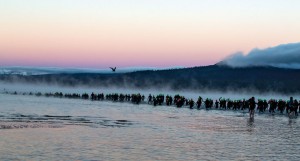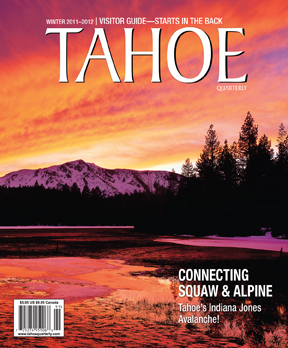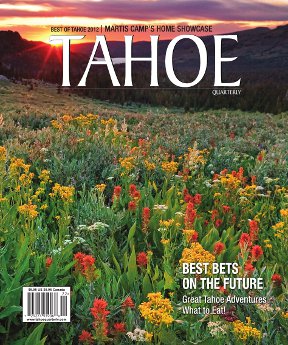Tahoe IRONMAN Tested Stamina, Strength
Written by Laney Olson
Steam rose from The Lake as thousands of athletes tried to keep warm in their wetsuits and swim caps. At 6:30 a.m. Sunday, September 22, the gun went off for the start of the inaugural Lake Tahoe IRONMAN, and athletes plunged into the frigid waters of the Big Blue.
IRONMAN was created in 1977 when John Collins, a U.S. Naval Officer stationed in Oahu, Hawaii, suggested combining the three hardest races on the island. In 1978, Collins, along with 15 other racers, swam 2.4 miles, biked 112 miles (shaving off 3 miles from the original bike race) and ran 26.2 miles.
Today, athletes compete in those same distances under a 17-hour time limit. There are more than 12 dozen annual IRONMAN races with the IRONMAN World Championships held yearly in Kailua-Kona, Hawaii.
The process of finding a new IRONMAN location began in 2011, says Keats McDonigal, operations manager for the World Triathlon Corporation,
“Tahoe is a great venue for IRONMAN due to the natural beauty and overwhelming support we have received from the local community.”
The Lake Tahoe IRONMAN drew nearly 2,700 competitors from 30 nations and 48 states; more than 3,000 volunteers offered support along the 140.6-mile race.
Racers began in King’s Beach, with 2 hours and 20 minutes to complete the 2.4 mile, two-loop swim. Athletes transitioned to the bike course, where they pedaled from Kings Beach through Tahoe City, northbound on Highway 89, through Truckee and southbound on Highway 267. On the third loop of the bike course, riders turned up Squaw Valley Road to end at the Village at Squaw; they had until 5:30 p.m. to finish the bike course. Finally, competitors had to run to Tahoe City and back twice before crossing the finish line in the Village at Squaw.
Of the 2,700 competitors, about 1,800 finished.
“The majority of athletes (who didn’t finish) did not finish the bike course,” says McDonigal. “This was due to a number of reasons including the time cut-offs, medical reasons or simply dropping out.”
However, he says, “IRONMAN shows people that dreams can come true if you put the time and dedication into your passions.”
This sentiment is especially true for Reno’s Jeff Dowling, 60, who finished his first IRONMAN with eight minutes to spare.
Like all racers, his story didn’t begin at the start line. Dowling raced triathlons for 11 years before deciding to compete in his first IRONMAN.
“I’ve done half IRONMANs. I was going to wait until I was 65,” Dowling says. However, after seeing his wife race the year before, he could not wait that long.
Dowling began his training with former professional triathlete and physical education teacher at University of Nevada, Reno, Scott Young. The first thing Young does when someone asks for training, he says, is “try to talk them out of it.”
When that fails, Young begins training athletes not only physically but mentally. His clients do lower-intensity, longer workouts. “It’s not unusual to do a 70-mile bike followed by an 8-mile run,” says Dowling.
However, physical strength is not the only thing racers focus on during training.
“During longer workouts, they go through many emotions, which prepare them for the ups and downs of the race,” says Young. “You have to be ready for disaster. You have to learn to keep going even when you’re in pain. You’ll want to quit but you can’t.”
Competitors like Dowling have a home advantage, knowing the roads and living at a high altitude. Most athletes come to the location of the race at least a week before to adjust to climate, McDonigal says. “With the altitude in Tahoe, we anticipate many athletes extending this longer than a typical IRONMAN race.”
Truckee bike and ski shop owner Paco Lindsay says he saw athletes throughout the summer. “There were 10 to 12 training camps with 30 to 40 people in each one.”
Locally, athletes ran into a huge obstacle while training: smoke. August’s Rim Fire in Yosemite forced many competitors to avoid outdoor exercise for several weeks. “Everything didn’t go quite as planned with the smoke,” says Dowling.
Despite setbacks, Dowling was ready come race day.
With the temperatures outside close to freezing and The Lake at nearly 60 degrees, racers welcomed submerging into the water. However, finishing the swim, racers ran into their first obstacle: the transition tent.
“The transition was chaos,” says Dowling. “There were too many people in a small area.”
Racers also battled cold temperatures on their bike ride. “With the air temperatures being colder than ideal racing conditions, athletes needed to plan accordingly, take more time in the transition and make sure they were wearing proper clothing,” says McDonigal.
The conditions infuriated Young.
“Is it really practical to have a race in Tahoe in September when there is a chance of snow? It’s putting athletes at risk for a dollar.”
Racers pushed through setbacks and crossed the finish line at Squaw. Professional triathlete Chris McDonald of Australia took his second IRONMAN title in less than a month with the time 8:55:14. Germany’s Maik Twelsiek came in two minutes later in second place.
For the women, Ava Lundstrom from Sweden took first with a time of 9:58:53. Jeanne Collonge of France followed 50 seconds behind in second place.
After battling hypothermia and a fall in mile 22 of the run, Dowling crossed the finish line with a time of 16:52. “It was the hardest thing I’ve ever done,” says Dowling. “The human body can do a lot of things you don’t think are possible.”
Racers faced an emotional finish. Announcers named each finisher individually, informing them they were an IRONMAN. Relief and tears could be seen on many of the racers’ faces.
IRONMAN Lake Tahoe brought many benefits to the community. “As a business person in town, it’s one of the greatest events I’ve ever seen,” says Lindsay, who says two-thirds of his sales this summer were from IRONMAN athletes.
The race brought in roughly $15 million in revenue from athletes, volunteers, spectators and IRONMAN staff, McDonigal says. Local charities received $50,000 from the IRONMAN Foundation along with $16,000 donated to the League to Save Lake Tahoe.
“Demographically, they have the highest income per amateur athlete,” says Lindsay. “They go to Tahoe, Truckee, Squaw, Northstar, they make good money and they spend good money. It’s a huge economic benefit for the community.”
IRONMAN has signed a five-year contract with Lake Tahoe. Next year’s race has been locked down for September 21, 2014. “The overall success of the event makes us initially believe that there will not be any major changes,” says McDonigal.







